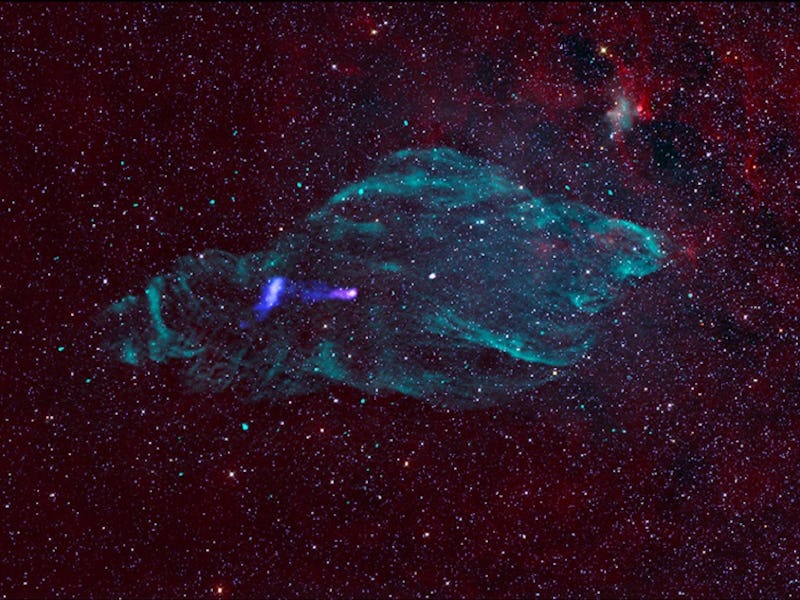A Potential Source of the Milky Way’s Highest-Energy Rays Is Mystifying Physicists
Some high-energy cosmic rays may come from twin jets of matter being ejected from a smallish black hole.

Some of the most energetic cosmic rays in the galaxy may come from a surprisingly small source.
If Max Planck Institute for Astrophysics researcher Laura Olivera-Nieto and her colleagues are right, they may have just pinpointed one of the sources of the high-energy cosmic rays that occasionally zip past Earth from the far reaches of the universe. Astrophysicists have spent years puzzling over the origin of these particles: protons carrying thousands of trillions of electron volts of energy (yes, cosmic rays are actually particles; early physicists thought they were radiation, and the name stuck). Some cosmic rays seem to come from supernova remnants, but it turns out that at least some high-energy cosmic rays may come from the twin jets of matter being ejected from a smallish black hole.
Olivera-Nieto and her colleagues published their work in the journal Science.
NASA’s Chandra X-Ray observatory spotted the x-ray jets from SS 433 several years ago.
A Cosmic Ray Culprit
The astronomers used a telescope called the High Energy Stereoscopic System, or HESS, to observe gamma ray jets from SS 433, a black hole orbiting a mid-sized star at the heart of the Manatee Nebula.
Like most actively feeding black holes (whether the small ones left behind after the collapse of dying stars or the cosmic leviathans at the heart of galaxies like our Milky Way), SS 433 is ejecting twin jets of matter at nearly a quarter the speed of light. These jets glow brightly with x-rays, which is how astronomers first spotted them several years ago. But about a light year away from the black hole, in both directions, the x-ray jets seem to fade away only to reappear with a vengeance about 75 light-years away.
When Olivera-Nieto and her colleagues examined the black hole in the even shorter wavelengths of gamma rays, they saw that twin gamma ray jets flared to life at exactly the points where the x-ray jets reappeared. In other words, it looked like the jets were fizzling out somewhere between 1 and 75 light years from the black hole, and then something revved them up again.
That something, the researchers surmise, seems to be a shock wave in the gassy interstellar medium of the nebula. Shock waves act like giant cosmic versions of the Large Hadron Collider, accelerating electrons in the jets to ludicrous speeds.
The jets glow with x-rays and gamma rays because electrons crash into lower-energy photons. When that happens, the electron gives the photon part of its energy, which ramps low-energy infrared light up to the high-energy x-rays and gamma rays that light up the black hole’s jets. The faster the electrons are moving, the more energy they transfer to the photons — so fast electrons make x-rays, and even faster electrons make gamma rays.
More importantly, at least for the mystery of cosmic rays, the jets may also be accelerating protons, and even whole atomic nuclei, to the absurdly high energy that turns them into cosmic rays.
Researchers have known for a long time that “the jets of SS 433 do, in fact, contain nuclei [of elements] such as iron or nickel. And the shock that accelerates electrons would accelerate them in the same way,” Olivera-Nieto tells Inverse. However, the protons could potentially be accelerated to even higher energies than the electrons because they’re too big to shed energy in collision with photons.
Astronomers just can’t actually see these high-energy protons and nuclei because, unlike electrons, protons release radiation when they bump into dense matter, not stray photons, and there’s not a big pile of dense matter in the black hole’s jets.
A Quest for Microquasars
Despite having shed light on this cosmic ray mystery, black hole SS 433 isn’t actually the source of any of the cosmic rays physicists here on Earth have detected. It hasn’t been blasting its relativistic jets out into space long enough for any particles from those jets to have reached Earth. But someday, in the distant future, there’s a chance some of the protons and atomic nuclei being accelerated in those jets could reach our planet.
Meanwhile, Olivera-Nieto and her colleagues say other similar objects, called microquasars, could still be among the sources of cosmic rays that do reach Earth.
“Microquasars are intermittent sources, meaning that it is very likely that other systems were active in the past and made a contribution to what we now see,” says Olivera-Nieto.
Looking for those sources is the next step.
“Detecting gamma-ray emission from other microquasar systems and understanding how acceleration takes place in them will be critical because it will allow us to understand how common such systems are,” says Olivera-Nieto. “Answering this question will constrain how much can microquasars as a whole contribute as sources of very-high-energy cosmic rays.”